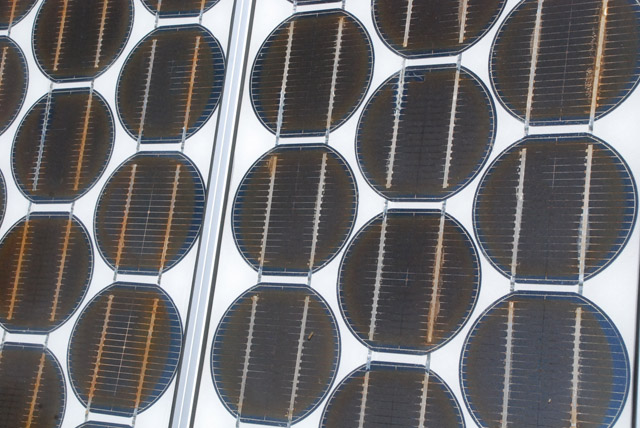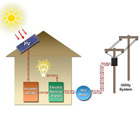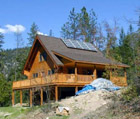

- Why Obtain an Independent Site Assessment?
- A site analysis is done to determine feasibility of, and type and size of PV system and approximate cost and return on investment. This can be done by an installation company, and they will charge you for the site assessment. If you obtain more than one quotation for a system, then you will be paying for this service more than once.
When this is done by someone such as ourselves who is not part of a sales driven installation company, our advice as to proceed or not is impartial. We can also consider types of systems that an individual company may not familiar with, that would be best for your site. A sales oriented company is biased to recommend what they can sell, is in stock and they know how to install.
Our site assessment is more detailed, and designed so you can send a copy of this to each company that you wish to have quote on your system. Each company will be quoting on an identical requirement. AND, you don't have to pay each company for the labour to do a site assessment. This is typically a faster method to obtain multiple quotations from installation companies.
- What do you do when you come to survey my site?
- Assess the roof type, size, condition and compass orientation and obstructions
- If the roof may be suitable, visit the attic and record the attic construction details and take pictures, then measure the roof, and potential obstacles to mounting and for sources of shading.
- If the roof is unsuitable, look for an alternative location for a pole mounted or ground mounted system
- If a potential location is found, then do a shade analysis for that location
- Discuss your expectations and the implications of various types of panels and locations and mounting systems.
- Discuss the implications of tracking systems in your location.
- Discuss manual seasonal tilt adjustment type of fixed systems.
- Produce a predicted amount of electricity the recommended system could generate per year
- Provide a rough financial analysis as an investment, which can be refined after you have firm quotes from several suppliers.
- Discuss any renovation plans and how solar energy can fit into those plans
- And naturally we collect payment for our service
Later at our office we process the data gathered and enter it into a simulation program, to more accurately predict the impact of shading, and the types of panels and inverters and the orientation of the site. Later when some quotes have been obtained, we can update the financial model and give you revised amounts.
- How do you determine the shading for different seasons?
- We use a tool called a Solar Pathfinder which uses a fish-eye lens to project the skyline of your site onto a graph lined with sun trajectories for each month, and time of day for each month. We do an on-site visual estimation based on this, and later on either at your site or at our office we enter this data into an analysis program that gives a more accurate determination of the loss of production due to shading throughout the year.
- What will a turnkey system cost?
- If you hire a company to do everything to put a net metering system on your roof you might expect to pay about $24,600 for a 10 kW system including HST. This is an average installed cost in Ontario in 2020 of $2.46/Watt. The study by the OREC non profit agency in Ottawa suggested a price of a net-metering system of $23,400 including HST for 2020. .
- Why would I be motivated to participate?
- Some people like the idea of being green in that they generate as much electricity as they use. They are delighted to have an overall hydro bill of nearly zero when averaged over the year, and they support the idea of solar energy displacing coal fired peaking generating stations. These people tend to put in a smaller, (less than 10K system) because it is all they can afford. These same people tend to try to minimize their own electricity use, and thus need a smaller than average Photovoltaic system to achieve a net zero use.
- Why all the concern about shade?
-
The heart of this subject is that solar panels are highly dependant on having the entire panel exposed to sunlight. If only one cell in a panel is shaded, the power output can drop to a 1/2 or by a 1/3. In a bulk inverter configuration this continues and a portion of the neighbouring panels that are wired in series also suffer. In brief, if there is some regular source of shade, then either the wiring arrangement of the panels is done to minimize the impact of the shade, or the system may provide a higher output if distributed inverters are used. A system with distributed inverters costs more for the parts, but can be more tolerant of shade. This is a complex subject, and is one of the reasons that you need experienced and knowledgeable people to assess the shade during the site assessment.
- Is a building permit required?
- A permit is required for most roof mounted systems. The fine print in the building code act is that a permit is required if the face of the solar array occupies more then 5m2 of area, which is a little less than a 1kWh system. So in practical terms, since such a system is too small to be attractive, then nearly all roof top mounted systems require a permit.
Pole mounted and ground mounted systems do not require a building permit, if they do not enclose any space.
- What type of inverters do you recommend?
- Installers love the per panel inverters or microinverters such as those made by Enphase and other companies, since they are easy to understand and to wire, are safer and do not require a DC disconnect switch. These also work well for a site that has some shading problems. They also provide a very nifty way of monitoring the health and output of each panel using an Internet connection. A DIY installation will be easier to do and safer than one with a bulk inverter. A system with these inverters fails gracefully if one inverter fails,while a bulk inverter system will produce no power if it fails. The repair technician also loves the ease of diagnosing the problem when something goes wrong. BUT if it is a roof mounted system it can be a pain to replace the inverter, since you have to remove the panel, or perhaps several panels to get to the inverter. In the winter this may be impossible for a DIY to do. On a ground mount or a pole mounted system this is not usually a concern.
- However a 10kWh system built with this type of inverter will cost more for the parts, and a string inverter will yield a lower cost system.
- The string inverters have been in use for a couple of decades and are very mature technology. For an investment motivated installation over 2 or 3 kWh the string inverter approach will be more economical. Normally a system with a string inverter will be more reliable, with only one device to fail, instead of 20 to 40 or so smaller units.
- On a large system, (over 3-5kWh) capacity with significant shading issues that can't be resolved by shifting location, etc. then a per panel inverter system may produce more power per year. Otherwise, if there is no shading, the bigger the system, the greater the advantage of the bulk inverter approach. If the prices of the Enphase inverters declines as volume of use increases, they may gradually become economical viable for bigger systems.
-
- Can You Help Me Install my Own System?
- Yes we can provide advice and on-site supporting consulting services, but some limits apply:
- You must do the electrical wiring yourself, or hire an electrician to do the AC side of the system.
- We charge a reasonable consulting fee for our time
- We will assess your ability to handle the challenges of such a project, and it should not be the first DIY project you have done. If you are getting out of your depth we will tactfully recommend that you get help with critical sections of the project, or even get a turnkey installation.
- Which way does my roof have to face?
- You get the maximum amount of power generation when the roof has an exact due south exposure. Please ignore any myths to the contrary. Also for a stationary system in the Ottawa Valley a 45 degree slope is ideal, but a 30 degree slope is 2nd best. The 45 degree slope will shed snow better, and will stay cleaner as rain will run down it more energetically. This is the best choice for an unattended system!
- What will a tracking system do for me?
- A typical system with dual axis tracking will produce about 30% more electricity. However this costs more, and it has moving parts, so it is less reliable. The additional cost will extend the time to break even. Your panels will still be working fine in 20 years, and will still be good for some more years of use. Will the company that made the tracking mount system still be in business in 20 years to service it if it breaks down?
- Are You Qualified?
- There is no formal qualification standard in Ontario. Our principle has taken a training course in Toronto at a not-for-profit environmental centre, currently said to be the best available. This course included training by the ESA on the application of the Electrical Safety Code to Photovoltaic Systems.
In addition he is an Electronics Hardware Designer,and thus understands the electrical part of the system thoroughly, and can diagnose and repair problems with a malfunctioning system. He has spent a career designing products, and is superlative at solving design challenges.
He owns a 10 kW microFIT ground mounted system that is connected to the grid. He did all of the work, and the ground mounted racking is his own design.
He also has designed and built with his own hands a super-insulated house and has done renovations on other houses.
He also is an NRCan certified Energy Advisor, trained to assess the energy efficiency of a home, and to promote better use of our energy resources.
- Where does the green power go?
- Some people pay more for green electricity to encourage switching away from coal fired generation. Some of the high price that the producers receive is recovered from such willing customers. The reality of an electrical grid is that the power you produce goes mostly to your own house and to those of your closest neighbours. It can't be steered to go only to the houses of those who are willing to pay more for green electricity.
- What happens after 20 years?
- Your Photovoltaic panels should still be producing about 84% of the power they produced when they were new.
Here is a picture of a solar panel that is located outdoors north of Toronto that was installed in 1982 and is still producing electricity on the day that I took this photo in 2010. Solar cell and solar panel manufacturing has improved since then, and are even more reliable.

- What happens if the power goes off?
- If the local hydro company has a power failure, the inverters will not continue to run, but will shut down within 1/30th of a second. This will protect the inverter from trying to drive a near short circuit load for it which would be the total load of your home and all your neighbours. It will also keep the hydro's repair crews safe. The technical term is anti-islanding. You will need a generator just like everyone else if you want to have power during a storm induced outage.
- There are some models of string inverters that permit you to have an emergency ciruit that starts up when the grid goes down. This does not supply the full output of the inverter, but typically 15A. However if the grid goes down after dark this feature is useless at night.
- Can I Cut Trees as Part of My Installation?
- The IESO has no rules about cutting trees. However there may be restrictions about tree cutting at the municipal level or by the Ministry of Environment.
- What is a WEEB?
- A WEEB is a short form for Washer, Electrical Equipment Bond . This name was coined by WILEY ELECTRONICS LLC. This part permits PV panels to be directly ground bonded to the aluminium mounting rails. The rails then connect to each other and ground. The part consist of special washers with sharp ridges on them that penetrate through the non-conductive coating of the aluminium module frames and mounting racks.
- Is A Licensed Electrician Required for hooking up the Panels?
- No. The homeowner has always been able to do this. Recently a lobby group tried to make this require a license, but that was defeated. March 31, 2012, the Ontario Labour Relations Board (OLRB) ruled in favour of the solar industry in its dismissal of an appeal by the International Brotherhood of Electrical Workers and the Ontario Ministry of Labour. CanSIA played a key role providing an industry focused submission illustrating, as the OLRB noted, that the matter had a far reaching impact. CanSIA realized from the outset that while the focus was in Ontario, the precedent set could have spread across the country. The appeal sought to remove the ability of non-electricians to perform solar installations. The issue centred on whether an "MC4 Plug In Connector" is considered a 'convenience receptacle' within the Ontario Construction Project regulations. If it had been determined that the MC4 was not a convenience receptacle, the IBEW argued that only certified electricians (or apprentice electricians) should be permitted to connect them. The ruling means that non-electricians are still able to work with these connectors provided they have the proper technical, health, and safety training.





